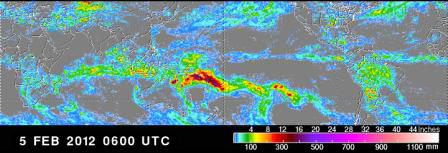
Rain can be a blessing or a disaster. An hour of steady rainfall can water the roots of plants and percolate underground to replenish water supplies. If the same amount of water falls in a five-minute downpour, however, the results are more likely to be uprooted plants, runoff and even flooding. According to new research, the effects of human activity on the atmosphere appear to be nudging rain patterns in the direction of faster and heavier.
In a paper published in Nature Geosciences, Prof. Ilan Koren, research student Reuven Heiblum and Dr. Orit Altaratz of the Institute’s Environmental Sciences and Energy Research Department (Faculty of Chemistry), together with Dr. Graham Feingold of NOAA-ESRL, Lorraine Remer of NASA-GSFC and J. Vanderlei Martins of JCET University of Maryland, Baltimore County and NASA-GSFC, looked at the rain rate — how much falls in a given period of time — for a large part of the globe. They then asked whether there is any connection between this rate and aerosols — tiny floating particles in the atmosphere. Aerosols often occur naturally, and they provide the “seeds” for the condensation of cloud droplets or, higher in the atmosphere, the nuclei for ice crystals. But today’s amounts are anything but natural: Burning fuels have added many tons of aerosols to the atmosphere over the past century. “For the first time,” says Koren, “we have managed to obtain a global picture of aerosols’ ability to change rain patterns.”

Prof. Ilan Koren
Koren and Feingold had previously shown how these aerosols affect cloud formation: Heavier loads of airborne particles stimulate the creation of more, but smaller, droplets. But the progression from cloud formation to rainfall is far from straightforward. Many different factors contribute, and diverse patterns of rainfall — from drizzles to torrential storms — arise from quite different weather conditions. Add to this the fact that rain is a widespread but sporadic occurrence, and it becomes quite difficult to formulate any hard-and-fast rules about cause and effect.
To assess rain rates — measured in millimeters per second — around the world, the researchers turned to satellite data. These satellites cannot, as they orbit, monitor absolute rainfall amounts, but they do measure rain rates for so-called convective cloud systems — well-formed clouds that produce relatively heavy rainfall. Data amassed from several different research satellites, collected over a several-month period in 2007 (see below), enabled them to evaluate rain intensity over large parts of the earth where convective cloud systems form, and also to assess aerosol pollution levels in the same regions.
The research team then looked for possible connections between the two, comparing satellite-generated maps of rainfall intensity with those in which aerosol pollution was sorted according to clean, mildly polluted or heavily polluted. Their analysis showed a very strong correlation: In over 80% of the areas in which rain fell from convective cloud systems, more pollution went hand in hand with higher rain rates.
Were aerosol levels really affecting the rain? Or could a third factor, for example, atmospheric instability, be the cause of both higher levels of particles carried in the atmosphere and greater rainfall intensity? To address this question, the scientists undertook a detailed meteorological analysis to see if their results would stand up in light of the hundreds of possible factors affecting rainfall. Most convincingly, when they divided their findings into levels of relative atmospheric stability, they found that added aerosols were tied to increased rain rates across the board, for stable as well as neutral and unstable conditions. This strongly implies that rising aerosol levels do, indeed, intensify rainfall.
Koren believes this phenomenon is mostly felt in areas in which rainfall patterns are close to borderline. In regions that are already flood-prone, higher rain rates might not significantly affect the flooding; and in arid regions, rain is too scarce for the rate to matter much. But somewhere in the middle, as more of the annual rains fall faster than the ground can absorb them, that beneficial rain may also bring more of the less-than-favorable effects.
The little satellite that could

Tropical Rainfall Measuring Mission data for a 24-hour period
Sometimes unplanned surprises can work in our favor. That is the case with the Tropical Rainfall Measuring Mission (TRMM), a satellite operated by NASA and the Japanese Aerospace Exploration Agency. When it was launched in 1997, carrying monitoring technology from the early 1990s, its projected life span was around three years, at the very most. In 2005, the agencies planned to destroy the TRMM with a controlled reentry, rather than letting it crash to Earth when it ran out of fuel. But scientists realized that the data it was providing were too important, and they even appealed to the US congress, getting a stay of execution to keep the TRMM in orbit. “The satellite has an orbit that allows it to cover much of the tropics and extract as much rainfall data over 24 hours (16 orbits) as possible,” says Koren. “The fact that it has refused to give up the ghost for 15 years means we were able to use it to produce a good, solid study.”
Dr. Ilan Koren’s research is supported by the Yeda-Sela Center for Basic Research.
Images: Jupiterimages and NASA
